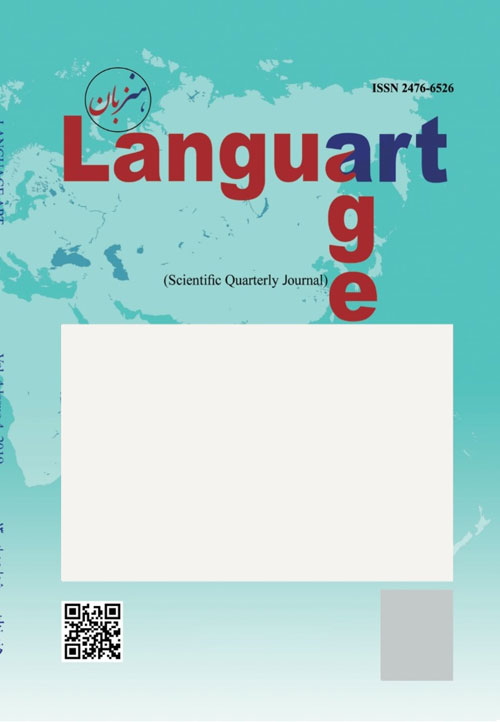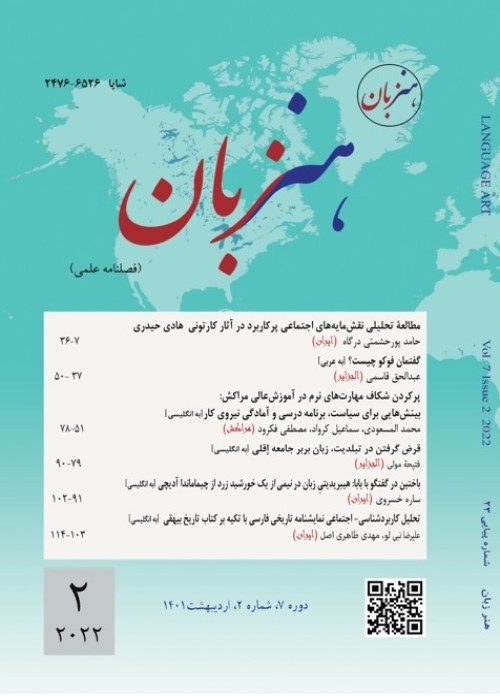فهرست مطالب

نشریه هنر زبان
سال چهارم شماره 4 (آبان 1398)
- تاریخ انتشار: 1398/11/26
- تعداد عناوین: 6
-
صفحات 7-32
-
صفحات 33-58
-
صفحات 77-94
-
صفحات 95-120
-
Pages 7-32
The poems presented by poets in each era, are generally contained in the form of poetic subjects. Glory is one of the poetic motives which has been common from the past up to the present in the Persian and Arab poems. In the contemporary period, the Glory Poem sometimes takes a new form which is presented by a specific exaggeration and on a new level so that the poem is included in the Narcissism School and the poet as a narcissist. The third verse of a poem by Hafez is not included in any poetic subjects although at first glance, it seems to be in the form of Glory Poem. In this research, after studying the Glory Poem in the poems of known poets and by considering the Glories of Hafez and those poems in contrast to Glory, we want to prove the fact that the mentioned verse by Hafez is of a different type. And this is a great claim which is manifested in the form of an obvious and glorious reality which considering its content will have great consequences.
Keywords: Hafez, The Glory Poem, Endeavor, Wise -
Pages 33-58
By studying the position of satire in the poetry of Iranian Islamic Revolution, it is possible to get familiar with the manner and style of the satirical poets of this period. Also, by analyzing the works of these poets, their ways of confrontation with social problems and their manners of expression will be explicit. The Literature of Revolution is insightful and informative. Fundamentally, satire is functionally informative. Therefore, doing research on this function in literature is highly important so that meaningfulness, informativeness, insight, and objection are clarified as the main components of the poetry of the Revolution and their key roles in its literature. The poetry of the Revolution is a socialist and diplomatic poetry and satire is responsible for raising the socialism, informativeness, and insight of people; so, explaining the position of satire in the poetry of the Revolution is in fact describing one of its most important content and meaning grounds. In this article, through Content Analysis and by using the method of collecting data in library, it is tried to verify the concept of satire, its level and position at this period by defining it and comparing its position with the different periods of the poetry of the Revolution and the forms applied. Then the famous poets of this style and their works will be introduced.
Keywords: Satire, Poetry, The Islamic Revolution -
Pages 59-76
Language is one of the most important human achievements to transfer thoughts and concepts. From the viewpoint of Cognitive Linguists, language is a tool to communicate everyone’s perceptual and cognitive system. Accordingly, poets and writers, especially mystics have applied language in a particular way so that it inspires cognitive, metaphysic, mystic and romantic concepts; also, they planned their themes by using language processes such as conceptual metaphor. Conceptual metaphor, at first developed by Lakoff and Johnson in the book “Metaphors We Live By”, is based on mind and experience. Lakoff believes that the themes of the human mind are fundamentally metaphoric, and even they are appeared through everyone’s daily life. As mysticism especially Mawlana’s mysticism is derived from his mystical experiences based on personal experiences, the present research has utilized the theory of Conceptual Metaphor by Lakoff and Johnson, based on types of metaphor and image schema for identifying the ideological themes of Mawlana by using a descriptive-analytic approach. In this paper, the conceptual metaphor of Love in animal symbols of Shams lyrics was propounded in two sections of schema and metaphor types. The results of the research suggest that the conceptual metaphor of Love represented in the two groups of force and path schema, and according to the types of metaphor, they are represented in the form of structural and orientation conceptual metaphors.
Keywords: Lakoff, Johnson, Conceptual Metaphor, Schemata, Mawlavi, Shams’s Lyrics -
Pages 77-94
Populism is a political term appeared with the rise of popular revolutions in Russia and France. Afterwards, it penetrates into literature. This term signifies advocating common people in politics, it follows the same trend in literature, too. The populist criticism culminates in France, because French critics were concerned with the literary works which treat low classes, undergrounds and miserable people. Tawfiq al-Hakim is an Egyptian prominent writer who studied law but devoted his life to literature and writing. He was a prolific writer who wrote in different styles. His works are characterized with commitment with the social problems and criticism of the social changes. Since the drama is written in dialogical form, it can deal with common people's concerns better than novel. Moreover it has no limitation in choosing the topics. This popular social spirit as well as his commitment to common people have made al-Hakim a popular writer. He exploited these themes to increase people's awareness and help them in managing their social problems. Applying the populist criticism, this article shows that Tawfiq al-Hakim's work was not a mere imitation of Western populistic works. His innovations can be found in selection of the themes and concentration on local problems.
Keywords: Populism, Tawfiq Al-Hakim, Common People, Drama -
Pages 95-120
The Lutys and all its other branches like hooligans, idiots, lumpens, and Tolerants who have almost disappeared these days, were a social group that had considerable roles in the political, cultural, and social processes just up to some years ago. In fact, this group were a transformed model for generosity and Ayyâri; they bound to most of their customs, conventions, and traits. Gradually, this group invented their own particular customs to be distinguished from others. One of their peculiarities was a special language with specific vocabularies, expressions, and tone which was common among them. The language, to some extent, has entered to the language of the other social classes’ esp. common people by means of this group. In this research, we tried to describe this language and its properties, and compose a dictionary of its vocabularies, idioms, and expressions
Keywords: Language Properties, the Lutys, Hooligan, Idiot, Lumpen -
Pages 121-144
Metaphor is a linguistic element that can be found in different languages, and the scope of the present study is restricted to the metaphorical expressions of only the two concepts of Happiness and Sadness as presented in Persian and Malay languages. The study uses of Metaphor Identification Procedure (MIP) and the Conceptual Metaphor Theory (CMT) framework. In this study, two sets of data (Persian and Malay linguistic data) were examined. The Persian linguistic data were collected from the Persian novel ‘Suvashun’ written by Simin Daneshvar. The Malay linguistic data were gathered from the Malay novels written by Wan Osman Wan Awang. These emotive metaphorical expressions were compared to assess whether they were identical, similar, or different. The analysis of data showed that emotive metaphorical expressions of Happiness and Sadness are characterized by cognitive commonness and cultural variety. The findings show that the two languages have many metaphorical expressions of Happiness/Sadness that are based on common bodily experiences. Furthermore, the analysis of metaphorical expressions of Happiness and Sadness in the two languages showed that the metaphor is quite pervasive in expressions of emotional concepts, and it plays an essential role in our understanding and speaking. The results of this study suggest that the application of Metaphor Identification Procedure (MIP) offers a reliable and flexible method for identifying metaphorical expressions at the linguistic level and the Conceptual Metaphor Theory (CMT) provides a systematic instrument to identify the concepts of emotive metaphorical expressions behind the linguistic metaphors.
Keywords: Metaphor Identification Procedure, Conceptual Metaphor Theory, Metaphorical Expressions, Happiness Metaphor, Sadness Metaphor


